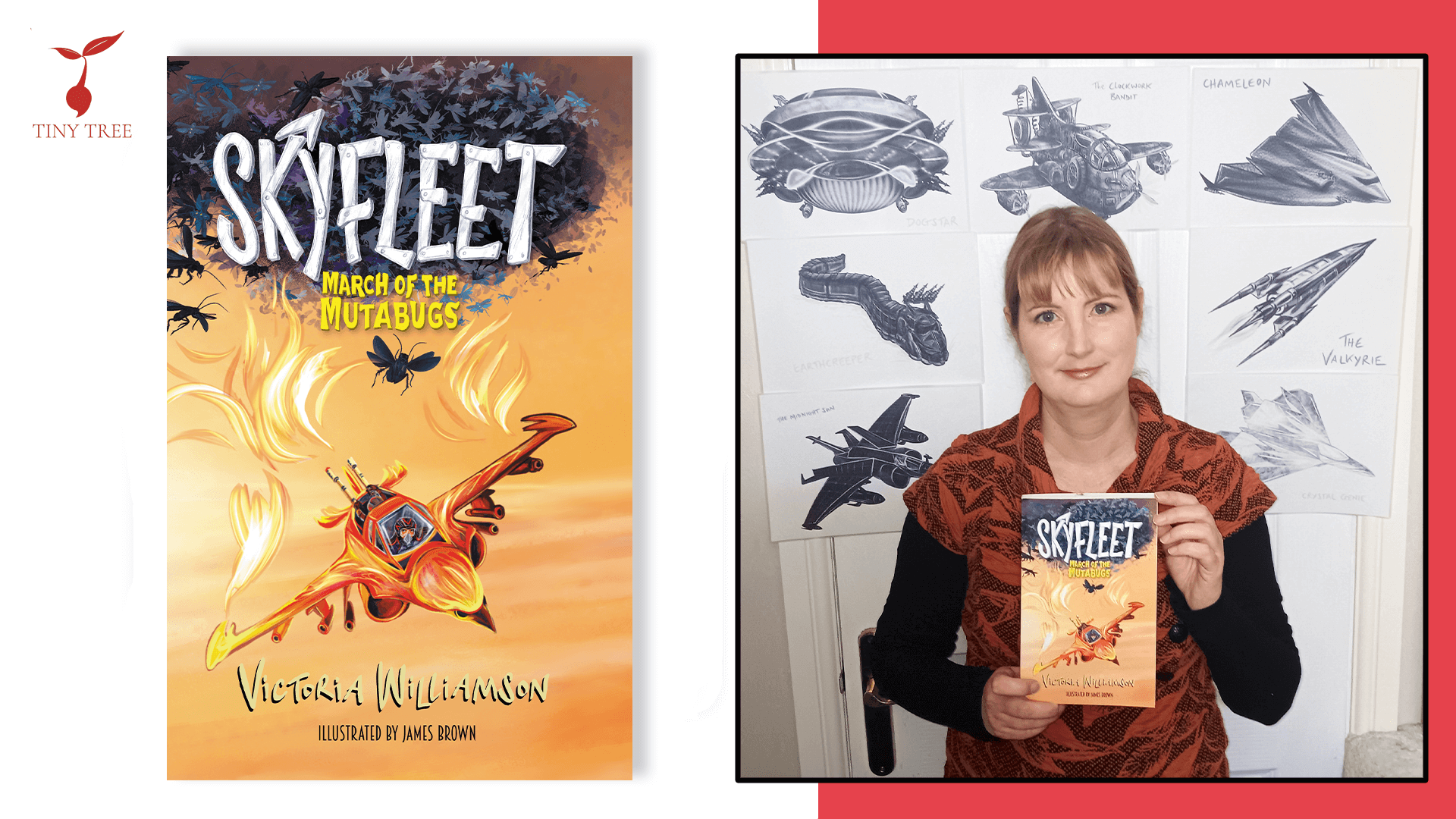
Victoria Williamson is the award-winning author behind ‘Skyfleet: March of the Mutabugs’ — a retro-futuristic fantasy action-adventure novel for middle-grade readers. The story follows Amberley and her best friend Ric as they attempt to restore a destroyed plane — the Firehawk — to assist the Skyfleet against a scourge of mutated insects known as Mutabugs.
In this exclusive Q&A we ask Victoria about building the world of Skyfleet, her influences, working with illustrator James Brown once again and get some insight into Amberley and Ric as characters.
Skyfleet: March of the Mutabugs is out now and available from all good bookshops!
Hi Victoria! We’re so excited about ‘Skyfleet: March of the Mutabugs’. If this is someone’s first time hearing about it, how would you describe the book?
This a fantasy-action-adventure story with friendship and overcoming the odds at its heart. It’s set in an alternative world that has both futuristic elements (the Skyfleet planes and the gadgets) but also has old-fashioned themes such as human labour to keep farming colonies going under difficult conditions. It’s about a pioneering spirit of adventure, and colonists who have come over from the ‘Old World’ to a dangerous ‘New World’ which isn’t quite as deserted as they expected. Not long after their ships land after a dangerous sea voyage, a meteor crashes into a toxic area of the Badlands, which spews radiation across the New World, contaminating the farmland and mutating the wildlife into monstrous creatures.
Tell us more about Amberley and Ric — the two central characters. What makes their friendship so special and how do they support one another throughout the story?
Amberley and Ric are very different children – Amberley is brave, but impulsive and doesn’t think things through before acting, while Ric is much more serious and measured and tends to overthink everything. His loyalty to his friend gives him great reserves of courage, though, and it’s Ric and his genius for fixing things who helps Amberley rebuild her family’s shattered jet when she’s given up hope and can’t see a way forward.
Despite their differences, they have a number of things in common which help them understand each other. Amberley’s legs have been paralysed in the crash that killed her parents, and she relies on technology such as a battery-powered wheelie chair and a three-wheeled zoomer to get around the Skyfleet base where they live. Ric is also an orphan and has been blind since birth, but like Star Trek’s Geordie La Forge, he has a special optikit that helps him to see. Amberley’s determination to get back in the pilot seat of her parents’ jet and prove that she deserves to be a member of the Skyfleet, and Ric’s determination to prove that he can be a valuable member of the engineering team are what kickstarts their journey to rebuild the Firehawk.
It’s a journey that takes unexpected twists, and Amberley and Ric test their friendship and bravery to the limit when the new Mutabug threat proves to be more dangerous than they could ever have imagined!
There are big themes of resilience and overcoming adversity throughout the book. How do Amberley and Ric’s journeys reflect those themes?
Amberley and Ric face difficult challenges throughout the story.
Ric is terrified of damaging his optikit, as the New World is running very low on repair parts and if he can’t repair it, then he’ll lose his sight. This makes him very cautious and risk-adverse, and at times he resents the fact that Amberley is so focused on her own mission to prove she can fly the Firehawk and become a pilot that she doesn’t take into account the risks that Ric is running in helping her.
Amberley, on the other hand, wasn’t born with a disability, so she is learning to navigate that while also dealing with the more recent loss of her parents. The jet is the one thing she has left to link her to her parents, and she is desperate to continue their legacy of flying the jet to keep their memory alive as well as to prove she can still be a valuable member of the Skyfleet team.
Amberley and Ric have to navigate these challenges and differences together, and it’s through understanding each other that they find fresh reserves of courage to tap into when the Mutabug threat proves to be more than the Skyfleet pilots can handle with their existing planes and everything seems lost.
Your books are known for their world-building. ‘Skyfleet: March of the Mutabugs’ is set on a far-future colony. How did you approach developing the world of ‘Skyfleet’ and is there anything readers should look out for?
One of the most exciting parts of writing a story is creating a new world with its own characters, locations, and rules. It’s such a lot of fun that many aspiring authors get stuck at this stage and spend years filling notebooks and computer files with ideas and pictures and never actually get around to writing anything!
I particularly enjoyed designing the Skyfleet planes and their different design features and special weapons systems, so readers should look out for the specifications for the planes that are inserted as ‘official Skyfleet document files’ at the start of some of the chapters, illustrated brilliantly by James Brown!
You’ve previously mentioned that the book was inspired by 1980s cartoons. What elements of the story in particular give off that feel?
Anyone who was a fan of The ThunderCats cartoon will recognise the idea of the Skyfleet base/Cat’s Lair in the jungle setting! That was my favourite cartoon as a child, and I loved the fact that there were two ThunderKittens – WilyKit and WilyKat – who often got a chance to go off on their own adventures and sometimes even save the other ThunderCats! That’s probably where the idea of Amberley and Ric saving the Skyfleet came from.
I also loved the gadgets the ThunderCats had and the hoverboards that WilyKit and WilyKat flew on, so that might have been the inspiration behind the planes, particularly the Firehawk jet!
The dreaded Mutabugs are the big threat throughout the story. How did you come up with them and, without spoiling too much, how do they affect Amberley, Ric, and the world around them?
Bugs – particularly spiders, scare the heck out of me! I can handle the ones that fly – wasps, dragonflies, that sort of thing. I don’t even mind spiders when they’re outside in the garden, where they should be! But if I see something scuttling across the carpet or legs twitching in the corner of a room, that’s when my brain goes all prehistoric and forgets how to function in a rational way! That’s why I chose giant insects as the ‘baddies’ in this story – they’re a threat that push a lot of people’s buttons, and most readers will understand why the colonists find swarms of giant bugs invading their villages so terrifying!
Design-wise the Mutabugs look like giant cockroaches or cicadas. You worked with James Brown again on this book, how do you think he captured them? And did you enjoy working with him again?
James Brown is brilliant to work with. He really ‘gets’ my writing style, and his illustrations complement the text perfectly. He has such a wonderful way of capturing ideas in the story and presenting them as visually appealing images. The giant cockroaches on the cover were his idea, which came from bouncing some concepts back and forth during the initial design process.
James really liked the first couple of chapters where Amberley and Ric have to escape from a swarm of giant cockroaches invading the base, and he came up with a great cover idea for the two children escaping on their zoomer. I loved the idea, but I really wanted the Firehawk jet to be represented on the cover as I felt its phoenix-like rise from the ashes after the accident summed up what the book was all about. So we combined the two ideas – the cockroaches from the first couple of chapters with the Firehawk jet – and James came up with an absolutely brilliant cover design that I know readers will love just as much as I do!
‘Skyfleet: March of the Mutabugs’ is aimed at middle-grade readers, but there’s lots in there for readers of all ages. What do you think makes a story like this so appealing to so many people?
I think adventure, friendship and overcoming adversity are themes that readers of all ages can relate to, regardless of the age of a story’s protagonists.
This story is also about pioneers who escape the overcrowded Old World and travel across a wide ocean to explore and settle on a new one, and the idea of a pioneering spirit and overcoming difficulties on a dangerous journey is one that still appeals to the modern imagination. I think that’s why people are so obsessed with the idea of colonising the moon and exploring Mars, and why this pioneering spirit is the inspiration behind many popular futuristic TV shows like Star Trek and Firefly.
At the time of writing, the book is almost in readers hands. How do you think readers are going to react to the story?
I hope they’re going to love it enough to want a sequel!
I have a whole notebook filled with ideas for adventures that Amberley, Ric and the Firehawk can go on next! And rumour has it that this isn’t the last time that the Skyfleet will be encountering strangely mutated creatures in the New World…
Finally, what would you like readers to take away from the book?
More than anything, this is a story of friendship, bravery in the face of personal difficulties and outside threats, and being determined enough to overcome the odds.
If readers take any of those things away with them, or if Amberley and Ric’s courage inspires them to be even just a tiny bit braver and try something they’d love to do but have been scared to up until now, then I’ll be very happy.
Skyfleet: March of the Mutabugs by Victoria Williamson, with illustrations from James Brown, is available now from all good bookshops. Order your copy today from Amazon, Waterstones, and Bookshop.org.

